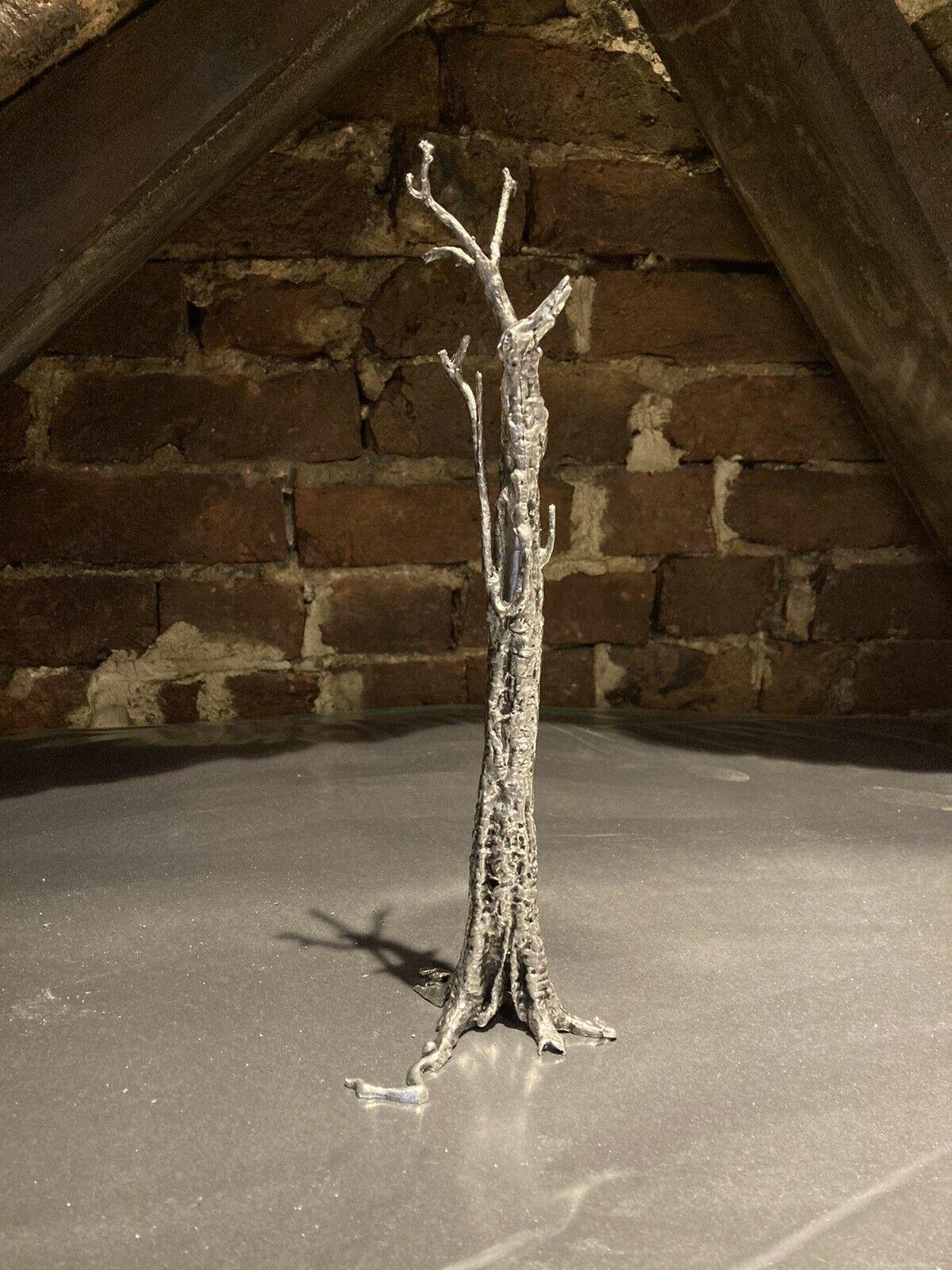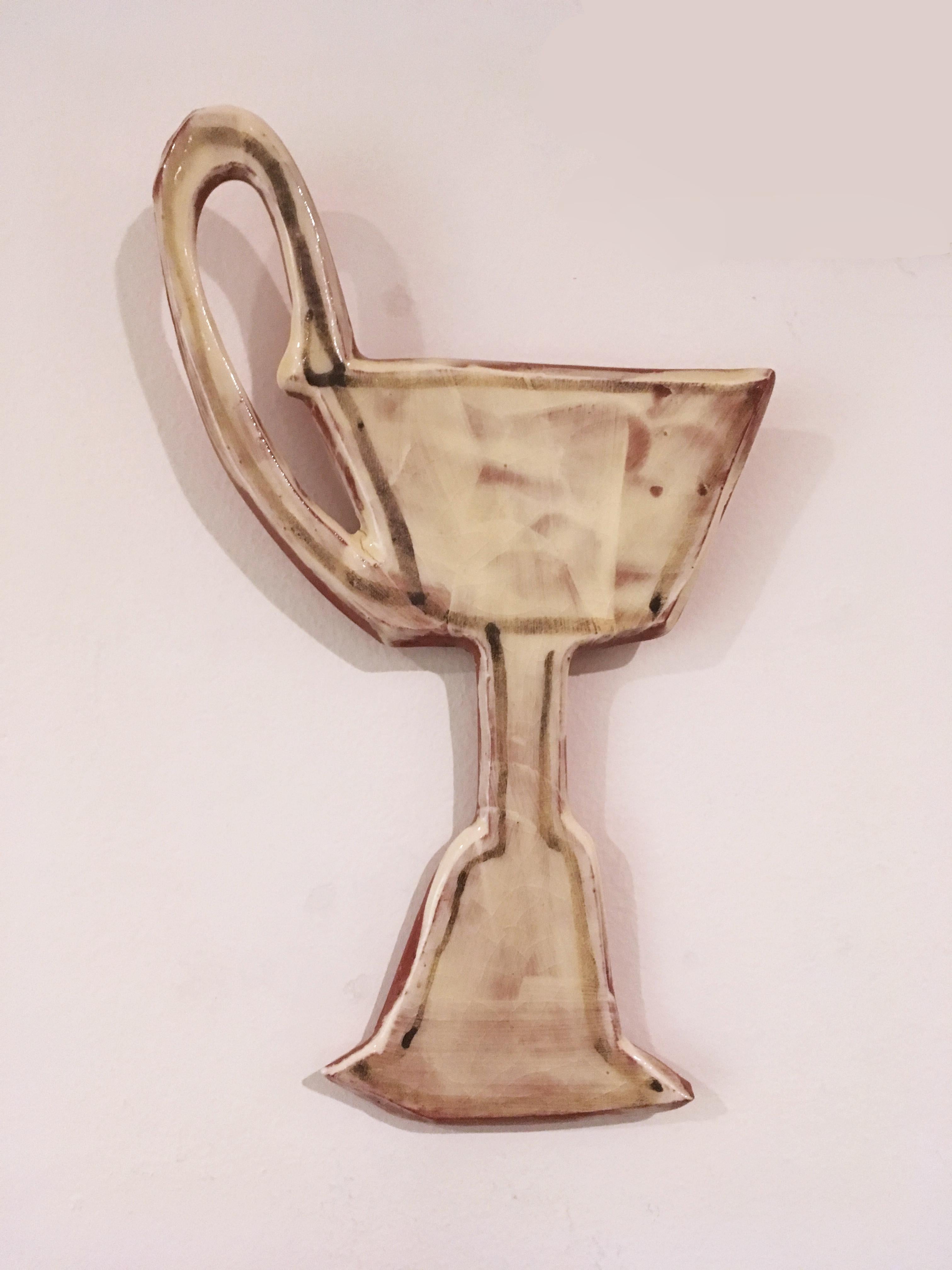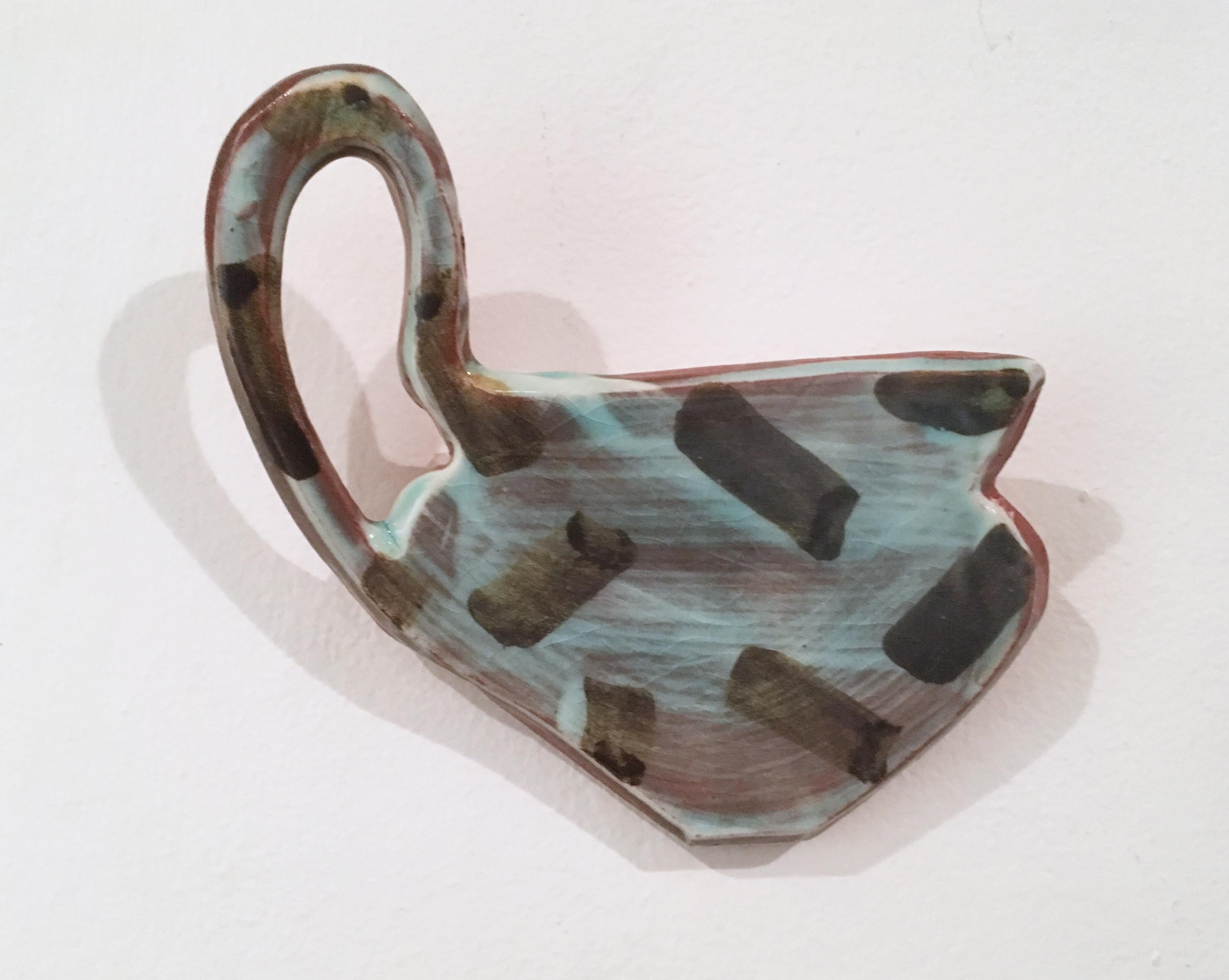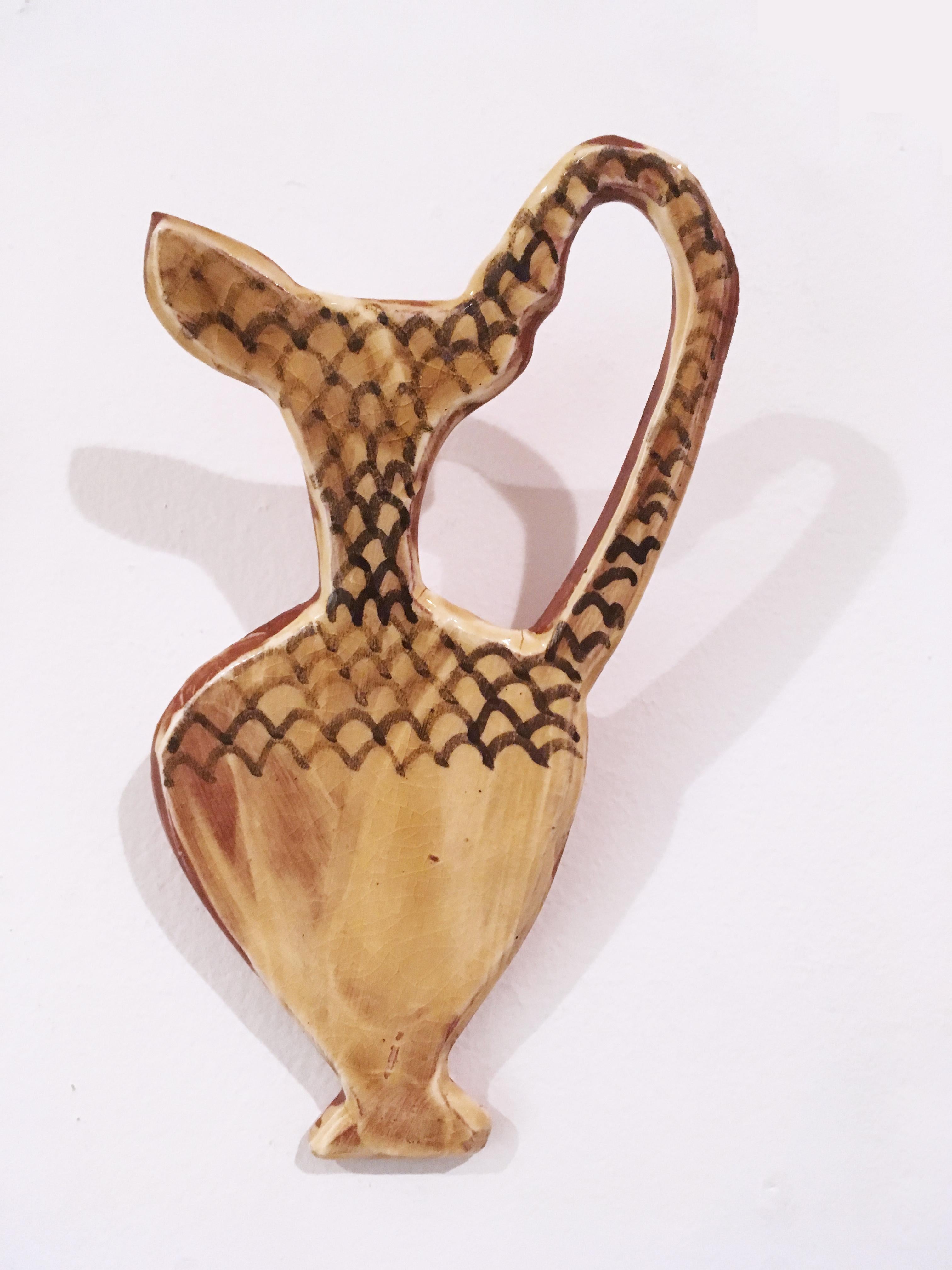Items Similar to Moroccan, Fez or Meknes: Tall bowl (Jobbana) with geometric designs
Want more images or videos?
Request additional images or videos from the seller
1 of 4
UnknownMoroccan, Fez or Meknes: Tall bowl (Jobbana) with geometric designs
About the Item
Provenance:
Collection of Emily Johnston De Forest and Robert Weeks De Forest, New York, by 1911-until 1942; thence by descent until 2018.
Literature:
Edwin Atlee Barber, Catalogue of the Mexican Maiolica Belonging to Mrs. Robert W. De Forest by The Hispanic Society of America, New York, 1911, p. 64, cat. no. 66 (no 1. only).
This beautifully decorated earthenware pot is a striking example of a 19th-century Moroccan jobbana. Traditionally accompanied by a domed or bell-shaped lid with a finial top, these vessels originally were used to store butter and cheese or to churn milk. The name, jobbana, derives from the Arabic word for cheese—jubna. The exterior of the bowl is decorated with ornamental motifs in bright blue applied over a yellow under-glaze. The organic diamond shapes separated by bands of intricate filigree and geometric patterns mirrored top and bottom are characteristic of ceramicware from Fez and Meknes, as is the reddish color of the clay visible beneath the yellow glaze and in the few areas of small losses. The blue oxide used on vessels of this type allow us to date our jobbana to the middle of the 19th century. An example executed on a similar scale and retaining its original lid is in the Brooklyn Museum (Fig. 1).
This beautifully decorated earthenware pot is a striking example of a 19th-century Moroccan jobbana. Traditionally accompanied by a domed or bell-shaped lid with a finial top, these vessels originally were used to store butter and cheese or to churn milk. The name, jobbana, derives from the Arabic word for cheese—jubna. The exterior of the bowl is decorated with ornamental motifs in bright blue applied over a yellow under-glaze. The organic diamond shapes separated by bands of intricate filigree and geometric patterns mirrored top and bottom are characteristic of ceramicware from Fez and Meknes, as is the reddish color of the clay visible beneath the yellow glaze and in the few areas of small losses. The blue oxide used on vessels of this type allow us to date our jobbana to the middle of the 19th century. An example executed on a similar scale and retaining its original lid is in the Brooklyn Museum (Fig. 1).
- Dimensions:Height: 7.875 in (20.01 cm)Width: 10.5 in (26.67 cm)
- Medium:
- Period:
- Condition:
- Gallery Location:New York, NY
- Reference Number:1stDibs: LU1025777991

About the Seller
5.0
Recognized Seller
These prestigious sellers are industry leaders and represent the highest echelon for item quality and design.
Established in 1997
1stDibs seller since 2012
17 sales on 1stDibs
Typical response time: 11 hours
- ShippingRetrieving quote...Ships From: New York, NY
- Return PolicyThis item cannot be returned.
More From This SellerView All
- Head of a Young African ManLocated in New York, NYProvenance: Private Collection, Spain. This intriguing and enigmatic sculpture depicts the head of a young African man emerging from a circular opening ...Category
Early 1800s Figurative Sculptures
MaterialsTerracotta
- Portrait of Ni-PologLocated in New York, NYSigned, dated, and inscribed on the verso: Malvina Hoffman/ Den Pasar/ “Nipolog”-/ © 1932/ Bali Provenance: The artist; her estate. Literature: Mal...Category
1930s Realist Sculptures
MaterialsTerracotta
- A Guardian Angel and a ChildLocated in New York, NYProvenance: Cornelius Vanderbilt, New York; by whom gifted in 1880 to: The Metropolitan Museum of Art, New York (80.3.673); deaccessioned and sold: Christie’s, New York, 12 June 19...Category
17th Century Old Masters Portrait Paintings
MaterialsTerracotta, Gesso
- The Three MagiLocated in New York, NYProvenance: Private Collection, Spain. Known as Peruvian alabaster for its translucency and workability, Piedra de Huamanga is a highly prized material from the province of Ayacucho in Peru. In the 17th and 18th centuries, local craftsman in the town of Huamanga began to specialize in the production of small-scale, polychrome religious sculptures made from this distinctive stone. Huamanga sculptures are among the most accomplished examples of carving from the Spanish Americas, where polychrome wood sculpture was a far more common sculptural medium. These works, which were created as independent sculptures or as sculptural groups—such as our three Magi—were intended for ecclesiastical as well as domestics settings. Our three figures likely formed part of a larger Nativity group—a New World variant of the tradition of the Neapolitan Crèche...Category
Late 18th Century Figurative Sculptures
MaterialsAlabaster
- The Infant Saint John the Baptist with a LambLocated in New York, NYProvenance: James Byrnes, Los Angeles (1917-2011) Giusto Le Court was born Josse or Justus de Corte in the Flemish city of Ypres. His father Jean was a sculptor and presumably his earliest training was with him before he entered the studio of Cornelis van Mildert. The young artist was clearly influenced by the dominant Flemish sculptor of the time, Artus Quellinus the Elder, with whom he may have worked on the decoration of the Amsterdam City Hall. Following the lead of many northern artists he travelled to Rome, perhaps more than once, before settling in Venice around 1655. It was there, as one of a colony of expatriate artists, that he made his name as a sculptor. One of his first Venetian commissions was for the monument to Alvise Mocenigo in the Church of San Lazzaro dei Mendicanti, where Le Court sculpted the marble figures of Strength and Justice. He also collaborated with the celebrated architect Baldassare Longhena, most famously for the high altar of Santa Maria della Salute, where he carved the multi-figured altarpiece depicting the Queen of Heaven Expelling the Plague. The present marble sculpture depicts the infant Saint John the Baptist, reclining, wearing his traditional hair-shirt, embracing a lamb, and holding the bottom of his attribute, a reed cross. Attached to his shirt is a baptismal cup, with which he would become associated later in his life. Veneration of the infant Saint John the Baptist was prevalent throughout Italy and images of the saint in childhood—often called “Giovannino,” or little John...Category
17th Century Renaissance Sculptures
MaterialsMarble
- PersistenceLocated in New York, NYProvenance: Sables de Fontainbleau, Seine-et-Marne, France “Gogottes” are natural creations formed out of sands deposited in Northern France during the Oligocene Period, approximately 30 million years ago. Much later, in a process that has only recently become understood, groundwater rich in silica flowed through the sands...Category
15th Century and Earlier Naturalistic Abstract Sculptures
MaterialsSandstone
You May Also Like
- Ai Weiwei Pequi Tree Minature Tin Sculpture 1/100 Scale Edition of 250By Ai WeiweiLocated in Draper, UTPequi Tree Miniature is a sculpture, created from the most recent work by Ai Weiwei, Pequi Tree, 2018-2020, and produced at a 1/100 scale. The sculpture is...Category
2010s Still-life Sculptures
MaterialsMetal
- Flat Pot XVIII, 2019, Glazed earthenware wall sculpture cream & brown terracottaLocated in Jersey City, NJEarthenware and glaze "Flat Pot XVIII" (2019) Glazed earthenware flat goblet wall sculpture Hanging system on back side Earth tones, cream and brown on terracotta clay Certificate o...Category
21st Century and Contemporary Contemporary Still-life Sculptures
MaterialsEarthenware, Glaze, Terracotta
- Flat Pot XVI, 2019, Glazed earthenware wall sculpture, terracotta clay pastelLocated in Jersey City, NJ"Flat Pot XVI" (2019) Glazed earthenware flat vessel shaped wall sculpture Hanging system on back side Pastel tones, light minty sea foam green blue on te...Category
21st Century and Contemporary Contemporary Still-life Sculptures
MaterialsEarthenware, Glaze, Terracotta
- Flat Pot I, 2019, Glazed earthenware wall sculpture, flat tea cup, terracottaLocated in Jersey City, NJ"Flat Pot I" (2019) Glazed earthenware flat tea cup wall sculpture Hanging system on back side Earth tones and pastels, light blue with deep green on terracotta clay Certificate of ...Category
21st Century and Contemporary Contemporary Still-life Sculptures
MaterialsEarthenware, Terracotta, Glaze
- Flat Pot XIII, 2019, Glazed earthenware wall sculpture pitcher shape terracottaLocated in Jersey City, NJ"Flat Pot XIII" (2019) Glazed earthenware flat pitcher wall sculpture Hanging system on back side Earth tones and pastels, cream, beige, green, sea foam, light blue on terracotta cl...Category
21st Century and Contemporary Contemporary Still-life Sculptures
MaterialsTerracotta, Earthenware, Glaze
- Flat Pot VI, 2019, Glazed earthenware wall sculpture, flat pitcher, earth tonesLocated in Jersey City, NJ"Flat Pot VI" (2019) Glazed earthenware flat pitcher wall sculpture Hanging system on back side Earth tones, brown and beige design on terracotta clay Certificate of authenticityCategory
21st Century and Contemporary Contemporary Still-life Sculptures
MaterialsEarthenware, Glaze, Terracotta





